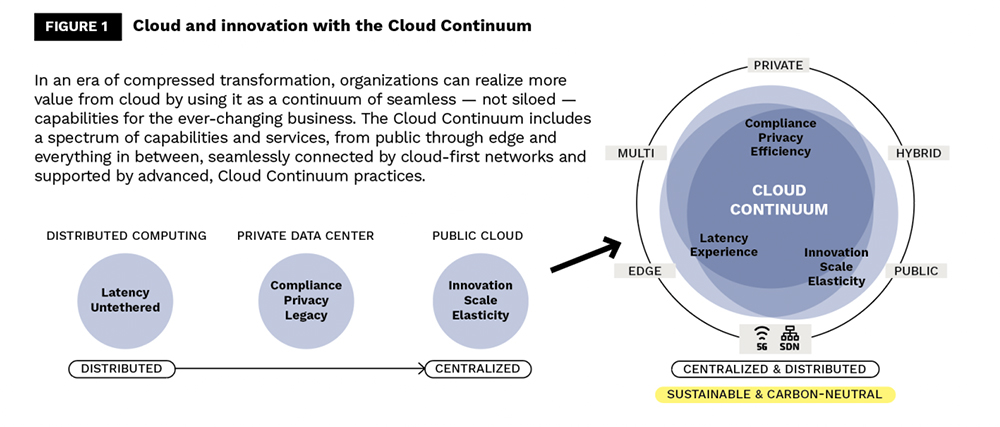By Jean-Marc Ollagnier, Sybille Berjoan, Surya Mukherjee and Gargi Chakrabarty
Most European business leaders think of cloud as shared, public data centers to host workloads for cost savings — and don’t use it enough for bigger business goals. Recognizing the cloud as a continuum of opportunities can put European companies on a competitive footing with their global peers.
Most European business leaders use cloud in their organizations today. Early on in 2020, when the world of business was reeling from a fast-spreading pandemic, European companies took a global lead in compressed migration, moving workloads to the cloud in months rather than years to keep up with changing behaviors. The result is impressive: nine out of 10 companies in Europe report cost savings on the cloud, much more than the seven out of 10 in North America.
But now, their early lead is dissipating; they risk falling behind.
That’s because many of them confine their activities on the cloud by viewing it merely as shared, public data centers that host workloads to reduce costs. Our research earlier this year found “cost savings” was the top priority for European senior executives in 2020; this is in sharp contrast to “increased customer value” for their counterparts in North America and “faster time to market” in China. Not surprisingly, European companies are not appropriately using the cloud and cloud-enabled technologies to target more ambitious business goals, such as sustainability and exceptional customer and employee experience.
Consider this: Chief executives in the US and China are beefing up their organization’s cloud portfolio. Their companies expect to grow investments between 5 to 8% in cloud between 2020 and 2024. In comparison, European business leaders say they will increase cloud investments by less than 3%. Our research shows European companies would have to grow cloud investments by 12.7% to reach where the US is today in one year. And at the current pace, it will take them three years to catch up. This gap will remain, and even widen if they don’t step up investment and leverage cloud in more significant ways.
Of course, a limited view is not the only factor holding back European companies from advancing on the cloud. To better understand how their cloud journey differs from the others, we relied on our global survey of 3,863 senior executives—spanning 16 industries in 25 countries—completed between late 2020 and early 2021.
We collected data on a variety of factors such as: a) adoption and scaling of technologies associated with cloud, b) the organization’s cloud journey, strategy, and goals, c) management practices around cloud, d) multiple measures of financial and operational performance, and e) the impact of cloud on innovation and sustainability outcomes. We supplemented that with interviews, case study research and economic modelling.
Evidence collected during our research suggest that many companies struggle to balance world class cloud innovation while navigating Europe’s complex regulatory landscape of data sovereignty and trust. These factors weigh down those organizations and create data silos that impede interoperability. In fact, six out of 10 European companies resort to creating data silos for sensitive data. These silos, which may seem unavoidable, can impede the development of robust data supply chains necessary to fuel innovation and value maximization.
Seeing opportunities in the Cloud Continuum
Chief executives at a subset of European companies—one in 10 in our research—have figured out how to address the specific challenges to advance on the cloud.
They recognize the cloud as a continuum of capabilities that can make them globally competitive and locally responsible. Today, the Cloud Continuum (Figure 1) spans different types of ownership and location (from public to private or hybrid to co-location to edge), all dynamically supported by next generation connectivity, such as 5G and software defined networks.

These business leaders make choices from across the Cloud Continuum to create a seamless technology and capability foundation for the organization that best serve their business needs now and into the future.
They view the cloud not as a single, static destination. Instead, they use it as an operating model that defines the organizational ways of working and behaviors. They promote “cloud first” applications, designed specifically for the cloud and not just on-premise applications modified for the cloud, for their value chains. And their board members back the ambitious cloud projects. We call these companies Continuum Competitors.
Take IKEA. Cloud defined the Swedish furniture group’s response to the pandemic. Business leaders responded to the crisis-fueled online shopping frenzy by instantly transforming the company’s technology infrastructure, converting closed stores into fulfilment centres, and enabling contactless ‘Click & Collect’ services while increasing the capacity to manage large web traffic volumes and online orders. Cloud technologies allowed IKEA to achieve in weeks what would normally have taken years or months – and the group has now put it at the heart of a permanent reinvention of operations.
4 steps toward Europe’s cloud success
Chief executives with the strongest orientation to cloud and cloud-based advanced technologies for decision-making achieved and even surpassed their business goals. Among the companies in our survey, the Continuum Competitors were three times more likely to “humanize” work and make it more interesting and less repetitive. Their carbon emission reduction was almost twice as much as companies with a less advanced use of the cloud. Most importantly, they achieved three times more cost savings than migration only companies.

These four steps can help guide companies toward a successful journey on the Cloud Continuum.
Step 1. Build a strategy backed by business cases to step-up investment
The C-suite may not be cloud experts, but their backing is crucial to kickstart ambitious cloud investments. To demonstrate that benefits of cloud projects outweigh costs, project teams must quantify the long-term as well as intangible benefits of the cloud. They also need to underscore the role of cloud in their company’s overall business transformation, including workforce and operational transformation. Cases must establish cloud’s innovative capabilities to create new products and services for future revenue streams.
Danish brewer Carlsberg’s Sail ’22 project — a strategy to cut operational costs and invest those savings in future growth — illustrates how to advance on the Cloud Continuum, with clear priorities, unwavering commitment, and heavy involvement of top leaders, was struggling to grow amid rising costs and evolving consumer tastes. Launched in 2016, Sail ’22 prompted Carlsberg to transition 100 percent of its global process workloads to the cloud, choosing Microsoft Azure as a partner.
“With cloud, our network capacity is 10 times what it was, which means our users experience much less latency,” says Carlsberg CIO Sarah Haywood. “The use of self service and bots, which respond to natural language questions, is far beyond what we had before.
“All this means our people get to focus their brainpower on those things that make a difference for our customers and consumers.”
Step 2. Create an architecture of balance, exert control and lead with trust
For any cloud solution to work given Europe’s regulatory landscape and business environment, it must be a three-legged stool comprising balance, control, and trust. Companies need to mix and match a variety of clouds to achieve balance, actively control where data resides and is processed with technology and hold their cloud providers to the same level of trust standards that customers expect of them.
Take Siemens AG. The company’s rapid pivot to Industry 4.0 and becoming a highly advanced industrial manufacturer a few years ago was largely enabled by the fluid architecture of the Cloud Continuum. Siemens’ business leaders recognized its customers – mostly engineering and manufacturing companies – could use vast amounts of data from their factories, equipment, and production processes to operate more efficiently. To do so, those companies would need to embrace digital transformation—driven by automation, edge, and cloud computing.
Today, Siemens’ multi-cloud strategy allows it to offer offers a range of cloud-based solutions to customers in many other industries, including healthcare and infrastructure, to suit their unique preferences.
Step 3. Establish cloud practices to support and augment your technologies
In a world where roughly one third of workloads are in the cloud, migrating and sitting back to enjoy the ride is not a winning strategy. The key is to couple technology adoption with practices that bring discipline and help bring a company’s non-technology areas up to speed.
There are six other top practices that a company must embrace to successfully expand on the Cloud Continuum.
- Feed it forward Agility: Speed time to future markets, again and again
- Continuous Goals: Alignment is continuous, not episodic
- Cloud first Apps: Cloud is the developers’ default
- Talent Transformation: Compress transformation continuously
- IT Experimentation: Unremittingly upgrade experiences
- Scale Awareness: Predict the power requirements for new generation of Cloud AI Services

Researchers at Swiss healthcare Roche used specialized NLP systems in a particularly novel way: To mine social media conversations and better understand symptoms that impact Parkinson’s patients. It was a new approach to data sourcing and analysis—both of which are native to the cloud—to rethink a traditional research process.
Werner Boeing, former CIO, Roche Diagnostics, said, “People believe that IT is about technology, but it’s really a behavioral science understanding the behaviors of your company’s staff, leaders and customers and facilitating the adoption of a new vision.”
Step 4. Accelerate innovation to deliver exceptional experiences
Continuum Competitors use a combination of human centered design and cloud-based technologies to rethink experience and disseminate throughout the entire organization including Products and Services, Employee Experience and Delivery Models. To them, experience obsessed reimagination of their business is a competitive differentiator, enabled only by the Cloud Continuum.
That’s the situation at Phillips, the Dutch multinational and its healthcare technology company. Philips began its journey to the cloud in 2014 with an open, cloud-based healthcare platform. The company took a step further in 2019 when it partnered with Microsoft to innovate on the Continuum for an operating room of the future. Here, Philips’ Azurion image-guided therapy platform will be combined with Microsoft’s HoloLens 2 holographic computing platform to provide augmented reality applications for minimally invasive therapies.
The Cloud Continuum is still a somewhat unexplored topic for many European business leaders. They must get started now and change the way they view the cloud to achieve substantial, sustained payoffs for their organizations in the future.
About the Authors

Jean-Marc Ollagnier is the chief executive officer of Accenture in Europe, with management oversight of all industries and services in Europe. He is also a member of Accenture’s Global Management Committee.

Sybille Berjoan leads the Accenture Research European team and drives the European Thought Leadership agenda.

Surya Mukherjee is the European tech research lead at Accenture Research in London.

Gargi Chakrabarty is a senior editor at Accenture Research in Boston



























